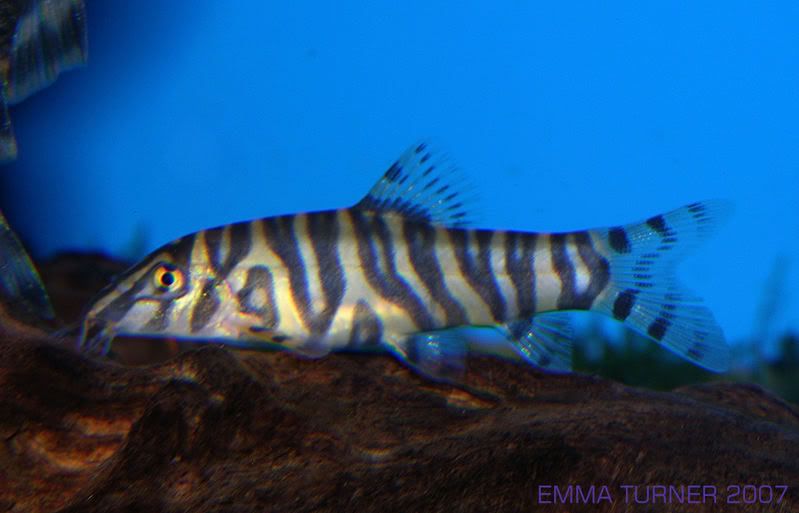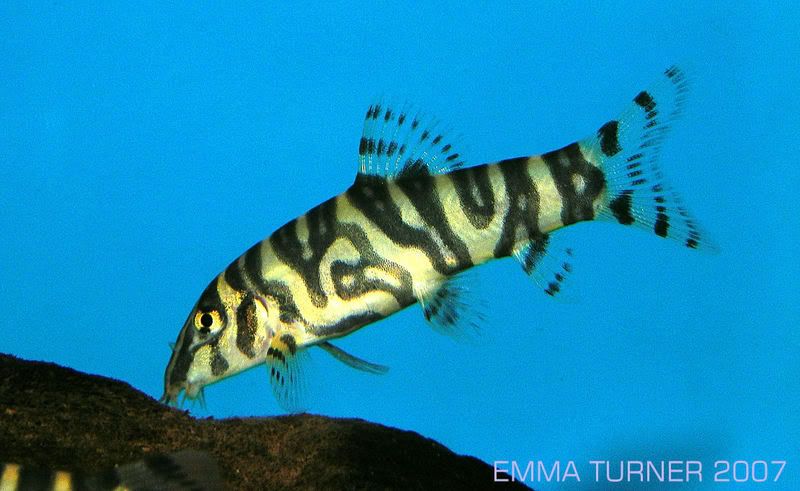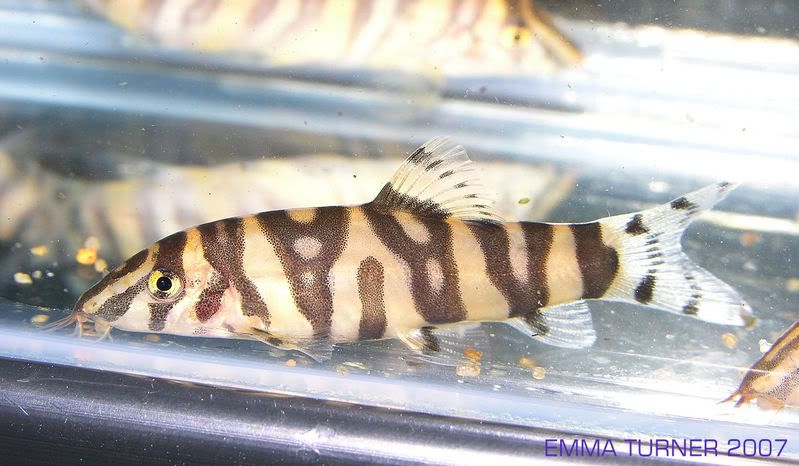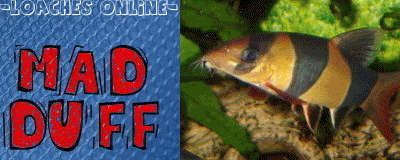Botia almorhae - from the Czech Republic....
Moderator: LoachForumModerators
- Martin Thoene
- Posts: 11186
- Joined: Wed Dec 28, 2005 5:38 am
- Location: Toronto.....Actually, I've been on LOL since September 1998
I believe that you're seeing dario in the general angle of the stripes right? I don't see it in the head profile though. That's where I see striata.
If we assumed there was striata genes in there then is there the possibility of stripe density increasing with age? Could be highly interesting even if it isn't exactly right.
Martin.
If we assumed there was striata genes in there then is there the possibility of stripe density increasing with age? Could be highly interesting even if it isn't exactly right.
Martin.
 Resistance is futile. You will be assimilated.
Resistance is futile. You will be assimilated.
- Emma Turner
- Posts: 8901
- Joined: Wed Dec 28, 2005 5:07 pm
- Location: Peterborough, UK
- Contact:
When observing them for some time, I saw no 'nippy' aggression which is typical in tanks of B. almorhae. With regards to the majority of the specimens in the shop, to me, they looked like more than a mixture of 2 species. The position of the stripes and head shape reminded me of B. striata, but the thickness of the stripes of B. dario. There were a few specimens that showed a hint of 'yoyo-ness' too, with fractionally longer head shapes and certain traits in the markings, such as these ones:



Then there appear to be patterns reminiscent of B. kubotai and B. rostrata. I think these chaps are really mixed up. Personally I don't agree with what is happening over in the Czech Republic, but at the same time, these fish are attractive and healthy and I can understand why people do like them. After all, it is not the fish's fault. I just wish the Czechs would use their technology to breed pure species.
If anyone in the UK felt like buying a group and charting their progress for us, they are currently at Maidenhead Aquatics in Lincoln.
Emma



Then there appear to be patterns reminiscent of B. kubotai and B. rostrata. I think these chaps are really mixed up. Personally I don't agree with what is happening over in the Czech Republic, but at the same time, these fish are attractive and healthy and I can understand why people do like them. After all, it is not the fish's fault. I just wish the Czechs would use their technology to breed pure species.
If anyone in the UK felt like buying a group and charting their progress for us, they are currently at Maidenhead Aquatics in Lincoln.
Emma

East of the Sun, West of the Moon.
correct me if I am wrong (it has been known to happen 
could some loaches we classify as different species just be a geographical variation? Like the variation we see in humans (whites and blacks) or dogs (etc).
If they can interbreed <even via injection> doesn't that mean that genetically they are really closely related and the same speices?
Also patterns and body shape do vary according to the environment in birds for example. These fish are impossible to breed in captive conditions so unless one does a DNA test who really knows.
I picked up a loach from a batch of kubs that looks more like a rostata or (dare I say) and emperior than a kub last weekend. Now I know it is young and the young tend to sometimes look like other types so time does tell.
could some loaches we classify as different species just be a geographical variation? Like the variation we see in humans (whites and blacks) or dogs (etc).
If they can interbreed <even via injection> doesn't that mean that genetically they are really closely related and the same speices?
Also patterns and body shape do vary according to the environment in birds for example. These fish are impossible to breed in captive conditions so unless one does a DNA test who really knows.
I picked up a loach from a batch of kubs that looks more like a rostata or (dare I say) and emperior than a kub last weekend. Now I know it is young and the young tend to sometimes look like other types so time does tell.
drain your pool!
For me, it's one thing to mess around with breeding for particular traits like fins, or color, or body shape within a species.
It's a whole 'nother thing to take two (or more) distinct species and mix them up. Can they even reproduce naturally after that?
There are a million morphs of angelfish. But they are angelfish.
Same with goldfish/bettas etc.
But botia?
It's a whole 'nother thing to take two (or more) distinct species and mix them up. Can they even reproduce naturally after that?
There are a million morphs of angelfish. But they are angelfish.
Same with goldfish/bettas etc.
But botia?
books. gotta love em!
http://www.Apaperbackexchange.com
http://www.Apaperbackexchange.com
- Whitey_MacLeod
- Posts: 291
- Joined: Thu May 17, 2007 12:27 am
- Location: Sheffield, England
I don't really have a problem with hybrids per se, as long as the resulting fish don't suffer. I'm not arguing in favour of blood parrots or any other hybrids that suffer from deformities, but I feel a lot more strongly about fancy goldfish bred to the point where they can barely swim than I do about these botia. They're clearly healthy and in good condition- life's no worse for them because they're hybrids. My ghost koi was one of my favourite fish, despite being a hybrid- very intelligent and entertaining, with the added bonus of being ich-proof 
Fast and bulbous!
- bslindgren
- Posts: 422
- Joined: Fri Jun 29, 2007 3:36 pm
- Location: Prince George, BC, Canada
I agree that hybrids just make life harder. Having said that I have to add that you (Emma) have a nack for posting pictures of fish that make us poor sods living in the hinterlands drool with envy. It's almost like Christmas when a LFS brings in something other than clowns (which I do adore, but there is the size-problem for most people [incl. yours truly who has to convince my wife that I need a bigger tank down the road - fortunately she is fond of my clown loaches]) or skunks. I've seen 'black kuhlis, yoyos (tiny), kubotais (I bought the lot when I found them), and small hillstreams (Beaufortia), minute horseface (Petcetera), and the banded tigers (Syncrossus helodes) I asked about a few weeks ago. Anyway, those fish (whether a colour variety or hybrid) are truly spectacular, but so are a lot of pure species, so no need to add to the confusion by hybridizing them, in my opinion. I agree with Martin - I'd have no problem owning them, but one would have to show some restraint in breeding them. Of course, the problem with that argument is that if there is a market, then the product will be delivered.
Given that these are Botia's, I don't see anything wrong with what they are doing, and some good.
Their hybrids are not going to breed, just because they are Botia's, and likely will not escape back to nature. At the same time, the more of these hybrids are sold, the more fish survives in the wild. Catching one animal in the wild means killing ten..or worse.
It still would be nice if they explained what they are selling exactly....
Their hybrids are not going to breed, just because they are Botia's, and likely will not escape back to nature. At the same time, the more of these hybrids are sold, the more fish survives in the wild. Catching one animal in the wild means killing ten..or worse.
It still would be nice if they explained what they are selling exactly....
-
Mark in Vancouver
- Posts: 14252
- Joined: Wed Dec 28, 2005 12:41 pm
- Location: British Columbia
I disagree, Mike. The kids and adults who collect wild loaches from Asian streams for a living will not hear about Czech genetic "advances" for years. The wild fish will be caught because of demand. The artificial fish will amount to a school report on how you can change nature to meet your supposed needs.
No wild loach will be saved because of a genetic experiment program in CR. Just human-designed fish rather than the ones we all hope you can find in rivers years from now.
No wild loach will be saved because of a genetic experiment program in CR. Just human-designed fish rather than the ones we all hope you can find in rivers years from now.
Your vantage point determines what you can see.
From what I know inbreeding causes more problems than hybridization, as in dalmatians for example, a breed of dog heavily inbred and as a result heavily prone to genetic disorders leading to blindness and deafness. White tigers are no longer bred as they come from a reduced gene pool and have a weak immune system as a result.
As for the ethics of the methods used to produce these hybrids I don't know enough but they may be not much different to the hormone treatment techniques used to captive breed a wide range of fish, many of which may be swimming around in your aquaria.
As for Sharis note on reproduction, a hybrid is almost always a sterile animal (i believe there to be one exception involving 2 types of frog), they don't know this and it doesn't seem to impact their quality of life. A mule will mount a mare despite his infertility.
I thunk newshounds note on geographical isolation is a valid one, a species was classified by being a sexually isolated group of individuals, geographical isolation is one possible cause of this isolation. Similar Botia species may well be different strains, or still be close enough related to produce healthy offspring as in the case of the horse and donkey.
As for the ethics of the methods used to produce these hybrids I don't know enough but they may be not much different to the hormone treatment techniques used to captive breed a wide range of fish, many of which may be swimming around in your aquaria.
As for Sharis note on reproduction, a hybrid is almost always a sterile animal (i believe there to be one exception involving 2 types of frog), they don't know this and it doesn't seem to impact their quality of life. A mule will mount a mare despite his infertility.
I thunk newshounds note on geographical isolation is a valid one, a species was classified by being a sexually isolated group of individuals, geographical isolation is one possible cause of this isolation. Similar Botia species may well be different strains, or still be close enough related to produce healthy offspring as in the case of the horse and donkey.
We shall see.Mark in Vancouver wrote:I disagree, Mike. The kids and adults who collect wild loaches from Asian streams for a living will not hear about Czech genetic "advances" for years.
If the Czechs manage to grab a piece of the market, this will cut down the demand for collecting: exporters don't need more than they can sell. Czech loaches are already sold in the UK and Canada, probably elsewhere in Europe too, they export some other fish to the US, so they should be able to expand here as well. And, in Europe at least, they should be price-competitive because of shipping costs. It surely looks like they are in for $, not for academic glory.
Compare to what happened/happening to Zebra Danios (90% bred, 10% export), Sids (almost fully farm bred), Galaxy Rasboras (tank bred are available, cheaper, and should replace the wildcaught in due course),...
And Czech fish is likely to be healthier too, no parasites or plagues, like the current Striata's...
- bslindgren
- Posts: 422
- Joined: Fri Jun 29, 2007 3:36 pm
- Location: Prince George, BC, Canada
For what it's worth, I've thought a bit about these particular fish, and I wonder if it is not a question of selective breeding rather than hybridization. If it was hybridization, I think you would expect more of a range of phenotypes from one parent to the other. These fish are remarkably consistent - the variation in pattern is not higher than in normal yoyo's (which it seems to me are rather variable anyway) or kubotai. Selective breeding would involve inbreeding, but as long as you keep adding fresh genotypes, there is no reason to expect that it would lead to problems per se. It does require some knowledge about genetics, though. If it is selective breeding, it would really be no different than albinos or long-finned specimens. You just ensure that odd phenotypes are preserved by careful breeding.
On the issue of fertility in hybrids - the stuff we learned in school about reproductive isolation always being genetic, i.e., hybrid offspring are sterile, doesn't always hold up very well. The Lake Malawi cichlids are a great example of where you can cross phenotypically very different species and get viable offspring. That is due to behavioural or geographic reproductive isolation in the wild, but the phylogenetic history isn't long enough to have isolated the fish genetically. I would expect that Botias are less closely related than the cichlids, but it isn't necessarily impossible to get fertile offspring from some parent species. For that reason extreme care must be exercised when dealing with hybrids, I think.
On the issue of fertility in hybrids - the stuff we learned in school about reproductive isolation always being genetic, i.e., hybrid offspring are sterile, doesn't always hold up very well. The Lake Malawi cichlids are a great example of where you can cross phenotypically very different species and get viable offspring. That is due to behavioural or geographic reproductive isolation in the wild, but the phylogenetic history isn't long enough to have isolated the fish genetically. I would expect that Botias are less closely related than the cichlids, but it isn't necessarily impossible to get fertile offspring from some parent species. For that reason extreme care must be exercised when dealing with hybrids, I think.
Who is online
Users browsing this forum: No registered users and 82 guests
